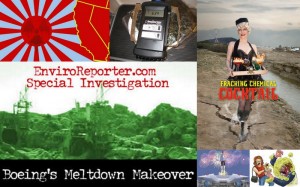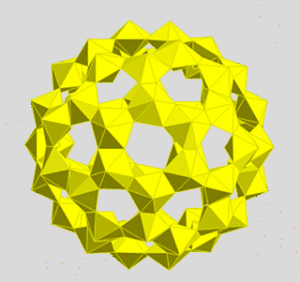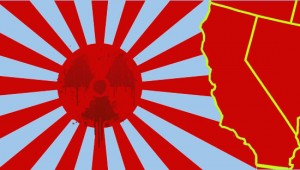 2012 was a hot year. Fukushima, Rocketdyne, Runkle Canyon and Farmer’s Field are just some of the stories that EnviroReporter.com covered. We not only dug deep to research and report the stories reviewed here, we connected the dots and provided evidence for readers to see for themselves.
2012 was a hot year. Fukushima, Rocketdyne, Runkle Canyon and Farmer’s Field are just some of the stories that EnviroReporter.com covered. We not only dug deep to research and report the stories reviewed here, we connected the dots and provided evidence for readers to see for themselves.
Radioactive Southern California air and Michigan rain, ionizing California food and astronomical radiation readings on jet aircraft made up just some of the over 2,560 radiation tests we’ve performed since four days after the Fukushima meltdowns began March 11, 2011. This testing continues 24-7 with our live feed of Radiation Station Santa Monica and eight other radiation stations in America and Australia.
Beginning the year, Seasons Readings documented hot Michigan rain registering in over 5.6 times background with another storm’s reading 6.5 times normal. We also detected radiation over five times what should be expected during flights across country, a threat we mitigated by wearing N-95 air filter masks.
In February’s Beta Watch we reported in depth on a new study that showed how the enormous amount of melted fuel at Fukushima is transforming itself into durable and fast-spreading radiation moving across the Pacific towards North America on the Kuroshio current. A U.C. Davis investigation looked at the impact of the millions of tons of fresh water and seawater poured onto the molten cores of the destroyed reactors. The conclusions were chilling. Nanoparticle buckyballs form as the water comes into contact with the melted fuel, which is intensely radiated, turning the water into peroxide.
 Though uranium isotopes are heavier than water, buckyballs are lighter because of their geodesic shape which is similar to a British Association football soccer ball. This structure makes radioactive uranium isotopes more mobile. Buckyballs can hold 60 uranyl ions in these spheres that exhibit high mobility in water. This is bad news because of its ability to spread Fukushima ocean contamination to Pacific Rim countries quickly. Equally troubling is that the study found that buckeyballs hadn’t decreased in ionization intensity after 294 days.
Though uranium isotopes are heavier than water, buckyballs are lighter because of their geodesic shape which is similar to a British Association football soccer ball. This structure makes radioactive uranium isotopes more mobile. Buckyballs can hold 60 uranyl ions in these spheres that exhibit high mobility in water. This is bad news because of its ability to spread Fukushima ocean contamination to Pacific Rim countries quickly. Equally troubling is that the study found that buckeyballs hadn’t decreased in ionization intensity after 294 days.
These hot nanoparticles, virtually indestructible, radiate and are a threat to anyone who inadvertently breathes them in where the buckyballs could induce lung cancer. Swallowing U60 buckyballs could also increase the chance of contracting cancer from its relentless radiation that is a so-called “bone seeker” that also targets the blood.
Not only did we explore this threat, we examined what those buckyballs and other Fukushima radionuclides would do once in the open sea. Radioactive sea spray has been shown to blow hundreds of kilometers inland in tests conducted in the United Kingdom by British and European researchers. As one who has ever smelled the salty ocean air miles from the ocean might expect, salt in sea spray can travel a significant distance. The same holds true for radioactive particles floating in the sea even if it they aren’t of the U60 buckyballs variety.
Sea spray-blown cesium 137 was found 200 kilometers from a discharge source in the New Hebrides islands in northern Scotland. The Cs-137 concentrations were so high that the bone-seeking radionuclide entered the food chain in island-grown produce. The vegetables were so hot that the dietary doses consumed by the islanders were the same and higher than workers’ dietary doses at nuclear power plants.
Studies found that the Irish Sea has a micro layer on top of it, perhaps only thousandths of a millimeter in thickness, that can get imbued with fine particulate material and its absorbed radiation. These concentrations of plutonium and americium are four to five times their concentrations in ambient seawater. Plutonium concentrates by 26,000 times in floating algal blooms at sea says a government report we cited and linked to in the article. Plutonium from Fukushima could also be hot glassing the surface of the Pacific in affected areas near Japan.
February also saw an investigation of what’s in pepper spray. Turns out that a lot of the really hot stuff is made with the rocket engine solvent trichloroethylene – TCE – as the majority of the ingredients. Extremely toxic at any level, TCE leaks from these cans and may endanger law enforcement. The investigation, which was published in LA Weekly, also found TCE-based pepper spray sold in major hardware stores in California without required Prop. 65 warning labels. TCE-based pepper spray packs a mean punch, one that can permanently affect vision.
In March we reported Radiation Readings Soar at Rocketdyne where cesium-137 clocked in at 9,328 times its background as shown in a July 2011 U.S. EPA “Radiological Background Study Report” for Rocketdyne soil. Shocking new radiation readings show a witches’ brew of deadly radionuclides on “The Hill.” Worse yet, the U.S. EPA pulled a bait and switch with the radiation background numbers threatening an agreement to clean the radioactive site back to its normal condition.
Both the federal EPA and state DTSC have ensured that these hugely inflated cleanup levels will leave the lab land nowhere near normal background radiation. Should SSFL remain essentially unremediated – as the government, Boeing, and its astroturfing allies are advocating – future open space or park users will be playing a game of Rocketdyne roulette depending on where they decide to picnic or hike. There will be no signs saying “Cesium-137 Hazard – KEEP OUT” because, as was exposed by EnviroReporter.com later in 2012, Boeing already thinks the place perfectly fit for public use.
Highest Radiation in L.A. Air Yet brought news no other Southern California news organization had the capacity or willingness to report. “The March 6 test of the combined dust came in at a sizzling 668% of background or 6.68 times normal,” the post reads. “Since the last testing period, the radiation detected has risen another 130% indicating a continued upward trend.”
 Rad News Digest, created and updated by Team EnviroReporter, began with news summaries and links back to the day that the Fukushima triple meltdowns began. Team EnviroReporter has documented thousands of the most important Fukushima and radiation-related news stories published to date since March 11, 2011. It takes dedication and diligence to pick the best articles and succinctly summarize their importance, and we are very grateful for Team EnviroReporter’s important contribution to our ongoing Fukushima coverage.
Rad News Digest, created and updated by Team EnviroReporter, began with news summaries and links back to the day that the Fukushima triple meltdowns began. Team EnviroReporter has documented thousands of the most important Fukushima and radiation-related news stories published to date since March 11, 2011. It takes dedication and diligence to pick the best articles and succinctly summarize their importance, and we are very grateful for Team EnviroReporter’s important contribution to our ongoing Fukushima coverage.
The contamination that EnviroReporter.com investigates knows no boundaries except those of ignorance of people who place power and money over the welfare of people and the planet. The extent of the problems presented by the triple meltdowns in Japan is explored at our Fukushima Investigation page. EnviroReporter.com‘s radiation monitoring also grew in 2012 with the addition of Radiation Station Sunshine Coast Australia and Radiation Station Simi Valley California in addition to our other Radiation Stations. These two stations are particularly active, involved and are superb at their mission.
The same day Team EnviroReporter’s Rad News Digest debuted was also the publication date of The Endless Bummer. The feature explores the potential impact of Fukushima radiation contamination for Southern California with the threat of uranium-filled “buckyballs” irradiating West Coast waters as the ocean of Fukushima debris comes closer.
On March 21, Rocketdyne Still Hot was published in support of the article by the same name in the Ventura County Reporter. The article and supporting material expanded upon our online coverage and exposed just how the government pulled a bait and switch on an unsuspecting and trusting public, gutting the Rocketdyne cleanup’s goal of remediating the polluted place back to normal levels of toxins in the soil and groundwater. While some of the science can be complicated, we made the trickery understandable:
“The EPA’s Radiological Trigger levels (RTLs), which are supposed to mirror the extensively tested and reported-on backgrounds of the numerous radionuclides at the site, were many times over the background threshold values (BTVs). So instead of cleaning up to background, much more radiation would be left in the ground, saving the government and lab owner Boeing millions in cleanup.
It is a classic bait and switch. And it almost worked.
It went unnoticed until this reporter spotted the huge discrepancy between the RTLs and BTVs because they were so obvious to anyone with any SSFL knowledge. Yet nobody else had noticed except, obviously, the EPA that created the PowerPoint with the bait-and-switched numbers in the first place.
One soil sample was laced with cesium-137 clocking in at 9,328 times its background, as shown in a July 2011 U.S. EPA Radiological Background Study Report for Rocketdyne in Table 8.4. Yet the EPA’s RTL in the PowerPoint is more than 25 times the same agency’s 2011 background study for subsurface samples of Cs-137, a cancer-causing radionuclide.
On a scenic bluff overlooking Simi Valley next to where the SRE once stood, leukemia-causing strontium-90 was assigned an RTL 6.47 times Sr-90’s BTV and tested at 284 times background.
Strontium-90’s RTL was more than 37 times its BTV in another sample. The hot dirt came in at more than 71 times background radiation, dug out a couple of feet below the surface. This suggests that even after two “cleanups” the area may still be facing a huge excavation job.
Fuzzy math also made its mark on the RTLs of tritium, carbon-14, cobalt-60, neptunium-239 and europa-152. All were detected by EPA at several multiples of their actual backgrounds.
Nothing could be more worrisome than the manipulation of the levels determined for plutonium-239/240. The isotope is one of the most potent radioactive killers on the planet, yet the EPA’s radiological trigger level was nearly 20 times its background. Exposure to even minute amounts of Pu-239/240 can give a person lung cancer.”
In April, we reported L.A. Rain Radiation Over Five Times Normal. An imperfect storm had swept into Southern California on, perhaps appropriately enough, April Fools weekend creating the conditions that tested EnviroReporter.com‘s scientific hypothesis that radioactive “buckyballs” and other fission radionuclides from the triple Fukushima Japan meltdowns were already impacting the region.
Sure enough, a rain composed primarily of sea mist formed over a choppy ocean with high winds tested higher than any other Los Angeles Basin rain since Radiation Station Santa Monica began fallout radiation tests March 15, 2011. The rain, not impacted by so-called “natural” radon progeny, came in at a whopping 506% above normal, more than high enough to qualify as a hazardous material situation for the California Highway Patrol.












Michael and Denise…..This summary of 2012 is absolutely overwhelming! Even one article alone is a knockout, but, putting them all together like this more than doubles the scary impact!
When it comes to Fukushima, you have done an incredibly huge amount of investigation and writing on a subject that our major newspapers seemingly do not want to to touch with even a 50 foot pole. Just knowing that Fukushima reactor#4 could cause a global disaster, and that some of our food items are radioactively contaminated has been reported only by you and Denise….and no other major newspaper, to say nothing of our Governmental agencies who are supposed to be protecting all of us in the USA.
And then there is the comedy going on up at the SSFL…our new and wonderful park. I, personally would never have understood the bait and switch positioning of the RTLS’s and the BTV’s without you. They don’t tell us this kind of thing at the technical meetings.
THANK YOU!
This reminds me of the debates I get into with nuke power advocates. I like to argue that if your efforts include a scenario that kills all life on the planet … you probably need different plans.
Let’s not mince words. We’ve all got thyroid cancer in our futures, courtesy of Fukushima. Maybe we should try using less energy rather than more pollution.
I agree with Bonnie. Great summary.
Q: How long will it be until the final summary reads…?
“The radioactive contamination from Fukushima has stopped.”
A: Beyond our lifetime and for generations to come.
I am very grateful to know Michael and Denise and thankful for all the excellent writing and details presented for our community on these critical topics. I love this comprehensive summary with all the links included.
@David – A huge catastrophe has indeed occurred at Fukushima and has not been brought under control. But it is not too late to close the barn door on reactor #4 – it is still standing and ready to topple (see Michael’s The Unforgettable Fire). Let’s hope TEPCO removes the fuel rods from the spent fuel pool at reactor #4 before it’s too late and the entire northern hemisphere is contaminated beyond habitability. Sadly, we can only “hope” this happens before it’s too late – the Japanese government is not allowing international assistance in that effort, the United Nations is not doing anything, the Canadian government has ignored the people’s petition urging them to get involved and the U.S. is promoting the use of nuclear power in Japan. But while we are hoping, we can, as Arnie Gunderson says, “watch it like a hawk” and decide where we will evacuate to if the absolute worst happens.
It is also not too late to close the barn door on all the 104 reactors in the U.S. that are still standing – and leaking and aging. 23 of them are GE Boiling Water Reactors that failed three times at Fukushima.
For 2013 I encourage everybody to get involved in shutting down your local reactor and stopping the insanity of the nuclear age. Join Beyond Nuclear’s campaign to Freeze our Fukushima’s: ” a national campaign created by Beyond Nuclear to permanently suspend the operations of the most dangerous class of reactors operating in the United States today; the 23 General Electric Mark I Boiling Water Reactors, the same flawed design as those that melted down at Fukushima-Daiichi in Japan.” http://www.beyondnuclear.org/freeze-our-fukushimas/ . Or find a local organization that is working to shut down the nuclear power plant closest to you. Always come back to Enviroreporter for the latest RAD NEWS. Get active and put as much time into it as you possibly can – before it really is too late to shut the barn door.
Great work, intrepid enviroreporters. Tragically, Fukushima is indeed a catastrophe for the whole world, and will be for a very long time, and there’s nothing we can do about it – just like GMOs – it’s too late to shut the stable door, the horse has already bolted. The human race and planet Earth were doing fine ecologically until the last century saw war and corporate fascism become all the rage. Then what a bunch of silly monkeys we seem to have suddenly evolved into – or been conned into…
@ Michael and Denise Thanks for the 2012 in Review. What an amazing amount of energy you both have so selflessly devoted to keeping a million and a half people informed. Your work has educated many about the radioactive contamination in their tuna, sushi, airplane travel and hiking adventures in LA’s Simi Valley. Inhaling that fine ocean mist now has new meaning for me as will the lovely smell of perchlorate at each fireworks demonstration. Denise, your creativity and costuming is unsurpassed. What you have both done this year is nothing short of spectacular reporting. On top of this you provide a forum for us in Radiation Conversation where we can share our knowledge and ideas. I am gratefully pressing the DONATE BUTTON and encourage all your readers to do the same and to contribute to this extremely valuable work. Wishing you both the very best in 2013!